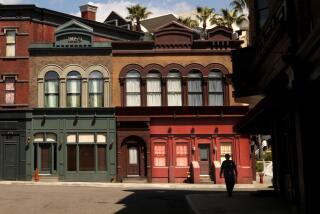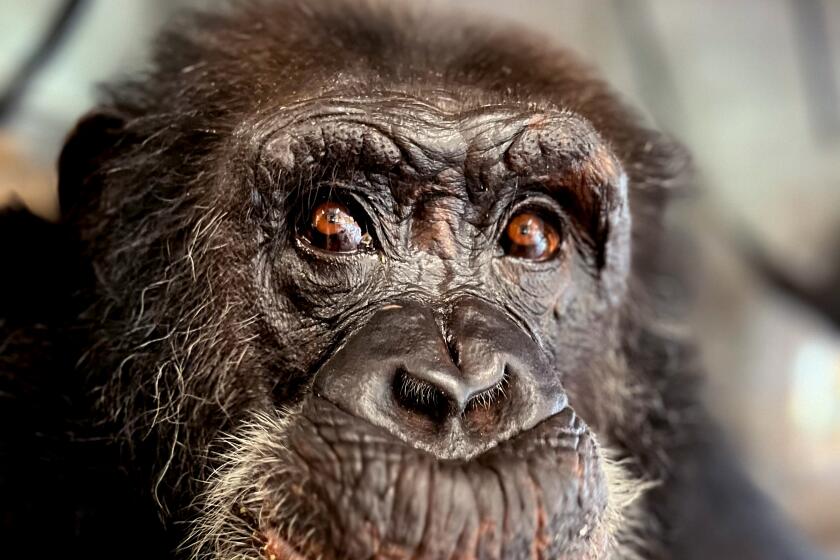New life for a Jerome Robbins ballet
Several major transformations are embodied within a single unusual hour of television airing on PBS Wednesday evening. A 1958 Jerome Robbins ballet, which astutely captured the essence of that moment’s younger generation, has been transformed into a highly contemporary dance film shot in unexpected New York City locations.
Beyond that, there is the improbable tale of two young New York City Ballet soloists who envisioned the entire project and became self-taught executive producers, fighting the odds to get the film made. Along the way, two youthful but experienced filmmakers, with no knowledge or expertise about ballet, directed an innovative film in which dancing -- along with the textures of New York City -- is captured with bracing energy and immediacy.
Robbins choreographed “N.Y. Export: Opus Jazz” on the heels of the hugely successful “West Side Story,” which he directed and choreographed. Its 16 dancers move with edgy, punchy wariness as well as playfulness, often seething with sensuality. Some view it as a distillation or extension of Robbins’ fascination with the musical’s youthful gangs. He made “Opus Jazz” for Ballets: USA, his short-lived but extremely popular company composed of quintessentially versatile American dancers, set to a pulsating jazz score by Robert Prince. It caused a sensation in Europe with its new approach to ballet -- technically rigorous yet with a finger on the contemporary pulse.
When “Opus Jazz” was introduced to New York in 1958, Lincoln Kirstein and George Balanchine immediately coveted it for New York City Ballet’s repertory. Robbins had been that troupe’s associate artistic director and choreographed there regularly since 1949. But it was not until 2005, seven years after Robbins’ death, that the company -- which maintains a vast Robbins repertory -- finally danced the ballet.
For Ellen Bar and Sean Suozzi, NYCB soloists who performed in that production, “Opus Jazz” was a revelation. “We thought we knew all Jerry’s ballets, because we’ve performed so many of them. But none of us had ever heard of this one,” Suozzi said recently at the David H. Koch Theater, where NYCB performs. “So the whole experience seemed like we were learning new choreography. Even though it was from the ‘50s, it did feel really contemporary to us.”
“We understood what the characters were about -- that they were disaffected. I think we all understood what it felt like to be young in New York City,” said Bar. “The ballet wasn’t a history lesson; it was much more about an emotional response: You’re a kid hanging out with your friends, looking at the audience like they’re an adult interloper.”
Bar and Suozzi sensed the ballet’s potential as a film. They felt that in contemporary clothes, danced in gritty urban locations, the choreography could resonate anew. Key to their conception was a series of brief interludes between each of the ballet’s five sections. They brought their concept to the Robbins Rights Trust, which zealously guards Robbins’ choreographic legacy.
Chris Pennington, executive director of the trust and the Jerome Robbins Foundation, said: “Based on Ellen and Sean’s respect and love for Jerry’s work and because they were so connected to this particular ballet and committed to re-imagining it for their generation, we just said ‘do it’ -- and they created a gem.”
Through mutual friends, the duo found the film’s co-directors, Henry Joost and Jody Lee Lipes, both (as are Suozzi and Bar) in their late 20s. “Ellen and Sean invited us to see the ballet. They said, ‘The [original] costumes are a little goofy, but don’t you think this would make a great film if we put it in street clothes, moved it out onto streets of New York?’ The next day we sat down together and started figuring it out,” recalled Joost. “We like setting rules for ourselves. We decided on five camera characteristics and matched them up with the ballet’s five movements. So the first section became all static shots, the second movement was Steadicam, the third is hand-held, the fourth is on the crane -- all one shot -- and the fifth is mostly dolly shots,” Joost said. The directors sought out offbeat, mostly abandoned-looking locations -- three in Brooklyn, one in Jersey City, one in Manhattan -- that were “spaces around the city that were secret places, where kids could go and just be themselves.”
Lipes scripted the interludes, designed to offer a subtle window into each of the five sections, by following a “character” from the ballet. Individual dancers are seen living their lives -- hanging out on a Coney Island beach, whiling away time in an arcade, riding the subway.
In a three-week whirlwind of fundraising, Bar and Suozzi raised the $50,000 necessary to film the ballet’s fourth section, a duet, in June 2007. The outdoor setting was the High Line, then an abandoned elevated train track in Lower Manhattan before its transformation last year into a greenspace. Rachel Rutherford and Craig Hall performed the moody, questioning duet at sunset on the weed-strewn tracks as the camera, operating on a crane in a single take (except for one edit), almost caresses them one moment, then looms high above the next.
“Passage for Two,” as that section is titled, was shown in various venues starting in late 2007 and impressed many. But a long wait lay ahead, until funding was in place to film the rest of the ballet. (The film’s budget eventually totaled $850,000.) The other four sections (ranging from six to 16 dancers) offered greater logistical and financial challenges. The Robbins Foundation provided crucial initial funding -- the start of a lengthy, determined process for the novice producers. In the end, Bar and Suozzi obtained all their funding from individual donors. “We didn’t receive any grant money at all. We did all sorts of foundation grant applications and were rejected by every single one. It was exhausting and discouraging,” said Bar.
Once WNET, New York’s PBS station, came on board last year, Bar and Suozzi hustled to be ready for filming in late summer, when NYCB’s dancers have time off. They shot in sultry weather at a vast abandoned public pool and overnight on the grimy top floor of an empty waterfront building.
Finally, their initial conception was becoming a reality. The dancers recognized something special was happening. “I loved doing the film more than any other dancing I’ve done,” said Adam Hendrickson, the one dancer who worked on every day of last year’s intensive filming. He spoke fondly even of the most unforgiving setting, with its “unfinished concrete, bird crap and glass.”
“I feel more connected to Robbins’ work than anybody else’s I’ve danced. The audience gets to see the dancers being something more, getting into themselves. He is still there in his ballets; you still feel him.”
More to Read
The biggest entertainment stories
Get our big stories about Hollywood, film, television, music, arts, culture and more right in your inbox as soon as they publish.
You may occasionally receive promotional content from the Los Angeles Times.










